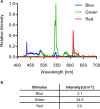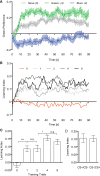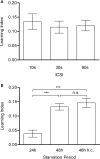Appetitive and aversive visual learning in freely moving Drosophila
- PMID: 20300462
- PMCID: PMC2839846
- DOI: 10.3389/fnbeh.2010.00010
Appetitive and aversive visual learning in freely moving Drosophila
Abstract
To compare appetitive and aversive visual memories of the fruit fly Drosophila melanogaster, we developed a new paradigm for classical conditioning. Adult flies are trained en masse to differentially associate one of two visual conditioned stimuli (CS) (blue and green light as CS) with an appetitive or aversive chemical substance (unconditioned stimulus or US). In a test phase, flies are given a choice between the paired and the unpaired visual stimuli. Associative memory is measured based on altered visual preference in the test. If a group of flies has, for example, received a sugar reward with green light in the training, they show a significantly higher preference for the green stimulus during the test than another group of flies having received the same reward with blue light. We demonstrate critical parameters for the formation of visual appetitive memory, such as training repetition, order of reinforcement, starvation, and individual conditioning. Furthermore, we show that formic acid can act as an aversive chemical reinforcer, yielding weak, yet significant, aversive memory. These results provide a basis for future investigations into the cellular and molecular mechanisms underlying visual memory and perception in Drosophila.
Keywords: behavioral assay; chemical reinforcement; classical conditioning; method; vision.
Figures










Similar articles
-
Distinctive neuronal networks and biochemical pathways for appetitive and aversive memory in Drosophila larvae.J Neurosci. 2009 Jan 21;29(3):852-62. doi: 10.1523/JNEUROSCI.1315-08.2009. J Neurosci. 2009. PMID: 19158309 Free PMC article.
-
Appetitive and aversive classical conditioning: Self-reports and physiological responses.Behav Brain Res. 2025 Apr 27;484:115509. doi: 10.1016/j.bbr.2025.115509. Epub 2025 Feb 27. Behav Brain Res. 2025. PMID: 40023255
-
Roles of Octopamine and Dopamine Neurons for Mediating Appetitive and Aversive Signals in Pavlovian Conditioning in Crickets.Front Physiol. 2017 Dec 12;8:1027. doi: 10.3389/fphys.2017.01027. eCollection 2017. Front Physiol. 2017. PMID: 29311961 Free PMC article. Review.
-
The strength of aversive and appetitive associations and maladaptive behaviors.IUBMB Life. 2014 Aug;66(8):559-71. doi: 10.1002/iub.1310. Epub 2014 Sep 5. IUBMB Life. 2014. PMID: 25196552 Free PMC article. Review.
-
A New Behavioral Paradigm for Visual Classical Conditioning in Drosophila.Bio Protoc. 2023 Nov 5;13(21):e4875. doi: 10.21769/BioProtoc.4875. eCollection 2023 Nov 5. Bio Protoc. 2023. PMID: 37969763 Free PMC article.
Cited by
-
Diversity of visual inputs to Kenyon cells of the Drosophila mushroom body.Nat Commun. 2024 Jul 7;15(1):5698. doi: 10.1038/s41467-024-49616-z. Nat Commun. 2024. PMID: 38972924 Free PMC article.
-
Short neuropeptide F acts as a functional neuromodulator for olfactory memory in Kenyon cells of Drosophila mushroom bodies.J Neurosci. 2013 Mar 20;33(12):5340-5. doi: 10.1523/JNEUROSCI.2287-12.2013. J Neurosci. 2013. PMID: 23516298 Free PMC article.
-
Multimodal Information Processing and Associative Learning in the Insect Brain.Insects. 2022 Mar 28;13(4):332. doi: 10.3390/insects13040332. Insects. 2022. PMID: 35447774 Free PMC article. Review.
-
Color vision in insects: insights from Drosophila.J Comp Physiol A Neuroethol Sens Neural Behav Physiol. 2020 Mar;206(2):183-198. doi: 10.1007/s00359-019-01397-3. Epub 2020 Feb 4. J Comp Physiol A Neuroethol Sens Neural Behav Physiol. 2020. PMID: 32020291 Free PMC article. Review.
-
Diverse memory paradigms in Drosophila reveal diverse neural mechanisms.Learn Mem. 2024 Jun 11;31(5):a053810. doi: 10.1101/lm.053810.123. Print 2024 May. Learn Mem. 2024. PMID: 38862165 Free PMC article. Review.
References
-
- Bicker G., Reichert H. (1978). Visual learning in a photoreceptor degeneration mutant of Drosophila melanogaster. J. Comp. Physiol. A 127, 29–3810.1007/BF00611923 - DOI
LinkOut - more resources
Full Text Sources
Molecular Biology Databases
Research Materials

